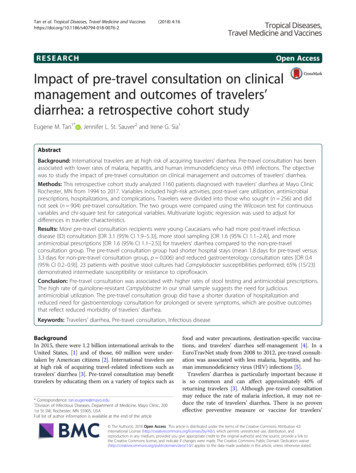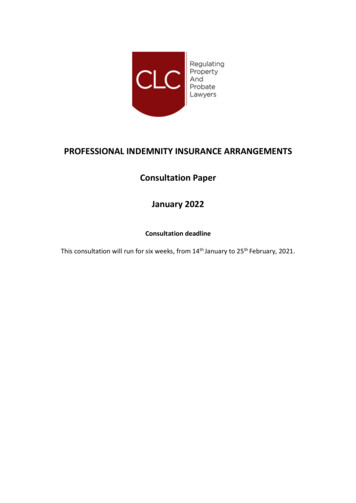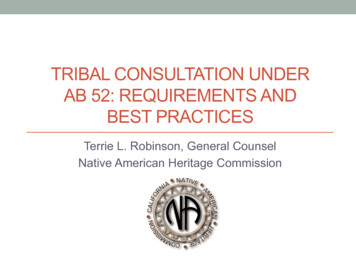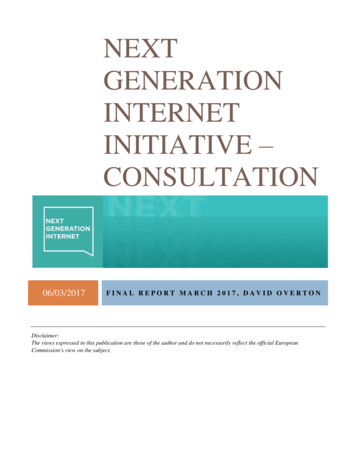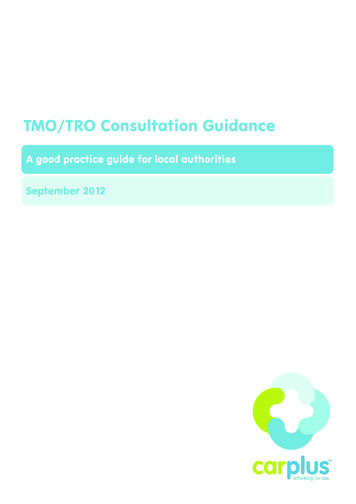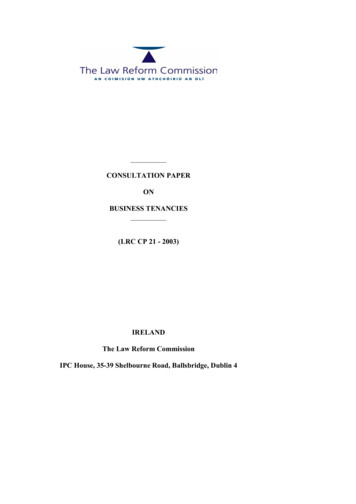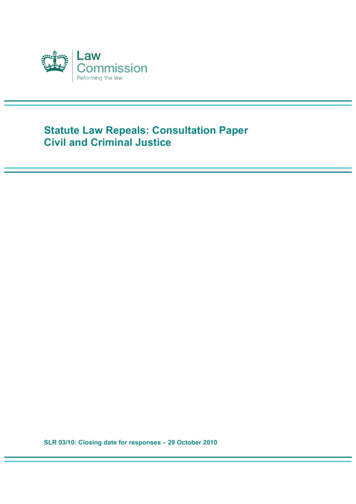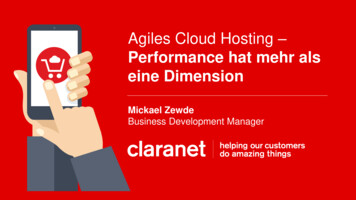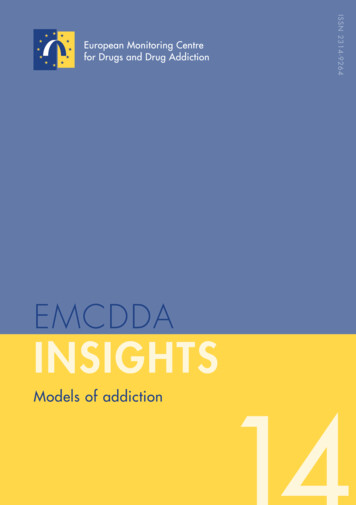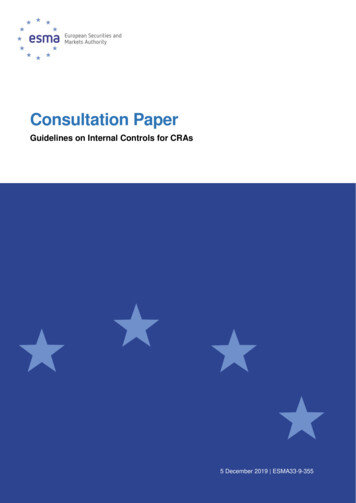
Transcription
Consultation PaperGuidelines on Internal Controls for CRAs5 December 2019 ESMA33-9-355
1
Table of ContentsResponding to this paper . 3Legislative references, abbreviations and definitions . 41.Executive Summary . 52.Introduction. 63.Internal Control Framework – Component Parts and Characteristics. 84.Internal Control Functions - Component Parts and Characteristics . 17Annex I Cost Benefit Analysis . 26Annex II Guidelines . 28Annex III List of Questions . 402
Responding to this paperESMA invites comments on all matters in this paper and in particular on the specific questionssummarised in Annex III. Comments are most helpful if they: respond to the question stated; indicate the specific question to which the comment relates; contain a clear rationale; and describe any alternatives ESMA should consider.ESMA will consider all comments received by 16 March 2020.All contributions should be submitted online at www.esma.europa.eu under the heading ‘Yourinput - Consultations’.Publication of responsesAll contributions received will be published following the close of the consultation, unless yourequest otherwise. Please clearly and prominently indicate in your submission any part youdo not wish to be publicly disclosed. A standard confidentiality statement in an email messagewill not be treated as a request for non-disclosure. A confidential response may be requestedfrom us in accordance with ESMA’s rules on access to documents. We may consult you if wereceive such a request. Any decision we make not to disclose the response is reviewable byESMA’s Board of Appeal and the European Ombudsman.The collection of confidential responses is without prejudice to the scope of Regulation (EC)No 1049/20011. Possible requests for access to documents will be dealt in compliance withthe requirements and obligations laid down in Regulation (EC) No 1049/2001.Data protectionInformation on data protection can be found at https://www.esma.europa.eu/data-protectionunder the heading Data Protection.Who should read this paperThis paper may be of interest to users of credit ratings, credit rating agencies and entitiesinterested in applying to be a registered CRA.3
Legislative references, abbreviations and definitionsCPCRACRA Regulationor CRARConsultation paperCredit Rating AgencyRegulation (EC) No 1060/2009 of the European Parliament and ofthe Council of 16 September 2009 on credit ratings agencies asamended by Regulation (EU) No 513/2011 of the EuropeanParliament and of the Council of 11 May 2011, Directive 2011/61/EUof the European Parliament and of the Council of 8 June 2011,Regulation (EU) No 462/2013 of the European Parliament and of theCouncil of 21 May 2013, and Directive 2014/51/EU of the EuropeanParliament and of the Council of 16 April 2014EU CRAA credit rating agency registered with ESMAESMAEuropean Securities and Markets AuthorityIC FrameworkInternal Control FrameworkIC FunctionInternal Control Function4
1. Executive SummaryReasons for publication1. The CRA Regulation includes a number of requirements relating to the internal controlsystem that a credit rating agency (CRA) must have in place in order to prevent or mitigateany possible conflicts of interest that may impact the independence of its credit ratingactivities.2. The purpose of this Consultation Paper (CP) is to clarify what ESMA considers to be thecharacteristics and components of an effective internal control system within a CRA.ESMA identified the need to provide this guidance during supervisory engagements, riskassessments and on-site investigations carried out during 2017 and 2018. ESMA formallycommunicated its intention to provide guidance on this topic in its supervisory workprogramme published in January 20191.3. In developing the guidance ESMA has considered a wide range of relevant requirementsand standards, including; the CRA regulations’ provisions relevant to internal controls;ESMA’s supervisory experience and existing CRA industry practices; EU approaches andguidance on internal control; and internationally recognised internal control standards.Contents4. The guidance is structured according to two main parts, establishing: ESMA’s views on the components and characteristics that should be evidenced byCRAs in order to demonstrate the presence of a strong framework for internalcontrols (IC framework); ESMA’s views on the components and characteristics that should be evidenced byCRAs in order to demonstrate the effectiveness of internal control functions withinsuch a framework (IC functions).Cost-benefit analysis5. A preliminary cost-benefit analysis of the Guidelines is included in Annex I of the CP.Next Steps6. ESMA will consider the responses it receives to this CP in Q1 2020 and expects to publisha final report by end of Q2 2020.1Section 3.2 ESMA Supervisory Annual Report 20195
2. Introduction1. The need for a CRA to have a robust and appropriately resourced system of internalcontrols is set out in Article 62 and Annex I Section A of the CRA Regulation. However,although the regulation is prescriptive about what minimum requirements a CRA’s internalcontrol system must conform to, it is less detailed about how the various elements of theinternal control system relate to each other as complementary parts of a unified framework.2. As ESMA has already communicated some of its expectations on internal controlsbilaterally with some CRAs during supervisory engagements, the purpose of theseguidelines is to ensure that ESMA’s expectations are shared with all registered CRAs aswell as future applicants. This will not only help ensure a level playing field but will alsofacilitate the adoption of consistent good practices across CRAs.3. The proposed guidance in this paper have been developed with reference to a range ofcontributing sources including the CRA Regulation’s provisions relevant to internalcontrols3; ESMA’s supervisory experience and existing CRA industry practices; EUapproaches and guidance on internal control4; and internationally recognised internalcontrol frameworks5. This has enabled ESMA to propose a set of practices that draw onexisting good practices while taking into account the specificities of the CRA Regulationand CRA’s business practices.4. The proposed guidance is structured according to two main parts, the first part focusingon a CRA’s overall framework for internal controls (IC Framework), the second partfocusing on the roles and responsibilities of different internal control functions within thisframework (IC Functions).5. Each part, IC Framework and IC Function, is further split into different components. Theguidance under the IC framework is split into the following five components: (i) controlenvironment, (ii) risk management (iii) control activities (iv) information and communicationand (v) monitoring activities.6. Under the IC Framework, ESMA sets out its expectations as to what steps should be takento evidence the presence of each component in a CRA’s internal control system. Forexample, with respect to the “control environment”, the guidance outlines the actions theCRA’s administrative or supervisory board need to take to establish a strong controlenvironment and set the right tone at the top.2See Article 6(1), 6(2), 6(4) and Section A of Annex I of the CRA Regulation (OJ L 302, 17.11.2009, p.1).See Article 6 and points 2-6 and 10 of Section A of Annex I of the CRA Regulation4 European Commission’s ‘Internal Control Framework’: Communication to the Commission from CommissionerOettinger, Revision of the Internal Control Framework, Brussels, 19.4.2017C(2017) 2373 final; European BankingAuthority, Final Guidelines on Internal Governance, EBA/GL/2017/11.5 COSO Internal Control – Integrated Framework, May 2013 2013, Committee of Sponsoring Organisations ofthe Treadway Commission (COSO), U.S.A.36
7. The proposed guidance on IC functions is similarly split into components which matchspecific internal control functions, namely; (i) compliance (ii) review (iii) risk management(iv) information security (v) internal audit. For these IC functions, ESMA sets out what therole of each function should be, what its reporting lines should be, and whether it can bemerged or combined with other functions.8. Each of the components of the IC Framework and the IC Functions are discussed in thefollowing sections of this CP. The approach of each section is to first provide a generalintroduction together with a description of roles and responsibilities in relation to the ICFramework or Functions. At the end of each section, there is a table setting out theproposed guidance.9. Finally, these guidelines have also been developed with a view to accommodating theproportionality that is provided for smaller CRAs under Article 6(3) of the CRA Regulation.Smaller CRAs may be granted an exemption from certain requirements under Section Aof Annex I of the CRA Regulation. In these cases, the guidelines set out that a CRA shoulddemonstrate that the responsibilities under each specific IC Function, even the ones forwhich an exemption was granted at registration, have been allocated and assigned withinthe CRA and are being achieved through other means.7
3. Internal Control Framework – Component Parts andCharacteristicsGeneral - Internal Control Framework10. The first part of these guidelines discusses ESMA’s expectations for an effective ICFramework. Specifically, the different components and characteristics that should beevidenced by CRAs within their policies, procedures and practices in order to demonstratethe presence of an effective IC Framework.11. The five components of this section are drawn from the COSO framework6. The approachof the guidance is to provide a general overview of ESMA’s view on the importance of therole of each component within an IC Framework. Following this, the guidance describesthe specific characteristics that ESMA would expect to see within a CRA’s internal policies,procedures and practices.12. The precise naming, format or classification these policies, procedures and practices canvary across CRAs. For example, some CRAs may choose to communicate theirrequirements through the form of “guidance”, “standard operating procedures”, “processdescriptions” or “walkthroughs”. For this purpose, the term “policies and procedures”should be understood as a general term that refers to any internal document that governshow the CRA or its staff should perform activities or adhere to requirements set out by theCRA Regulation.13. Irrespective of name, format or classification, documented internal policies and proceduresare important to ensure that the different components and characteristics of the ICFramework are embedded in a CRA’s practices. In this regard, the administrative orsupervisory board should be accountable for the implementation and approval of thesepolicies and procedures. It should also be accountable for ensuring that the CRA’s policiesand procedures are subject to ongoing monitoring and regular update.14. There should be a clear, transparent and documented decision-making process for themonitoring and updating of these policies and procedures. These policies and proceduresshould include a clear allocation of responsibilities and authority within its IC framework,which includes the business lines, internal units and IC functions.Proportionality – Internal Control Framework15. It is not necessary to provide principles relating to proportionality in the guidance relatingto IC Framework as these elements should be present within a CRA’s internal policies andprocedures regardless of organisational structure or resources.COSO Internal Control – Integrated Framework, May 2013 2013, Committee of Sponsoring Organisations ofthe Treadway Commission (COSO), U.S.A.68
Component – Control Environment16. The first component of the IC Framework is the control environment. An effective controlenvironment begins with the CRA’s Board and senior management setting the right toneat the top of the CRA. In creating the conditions for an effective control environment, theguidance establishes that the CRA’s administrative or supervisory board is accountablefor the adoption of a high level of ethical and professional standards relating to the conductof the CRA’s staff. The CRA’s senior management are subsequently responsible for thedevelopment and implementation of these standards and ensuring they take into accountthe specific needs and characteristics of the CRA.17. The CRA’s board should be accountable for ensuring that equivalent ethical standards areput in place for external services providers. The CRA’s senior management should beresponsible for developing these standards and putting in place mechanisms to overseeadherence to these standards by external staff. The CRA’s board is ultimately accountablefor the effectiveness of these mechanisms.18. The CRA’s senior management should be responsible for ensuring that the CRA’s staffare aware of the potential internal and external disciplinary actions for not adhering to theCRA’s policies and procedures. The CRA’s board should be accountable for the oversightof these policies and procedures, this oversight should include assessing whether anytransgressions have been properly addressed.Part 1: Internal Control FrameworkComponent1.1Control EnvironmentThe control environment is the set of standards, processes and structures necessary forcarrying out internal control across an organisation and the foundation on which aneffective system of internal controls is built.A CRA’s administrative or supervisory Board (‘the Board’) and senior management areaccountable and responsible for establishing the tone at the top regarding theimportance of internal control and exercise oversight of the development andperformance of internal control. It is the Board that is accountable for the adequacy andeffectiveness of the control environment.Characteristics 1.1.1 The CRA’s Board and senior management should beaccountable and responsible for establishing a strong cultureof ethics and compliance within the CRA through theimplementation of policies and procedures that govern theconduct of the CRA’s staff.9
1.1.2 The CRA’s Board and senior management should beaccountable and responsible for ensuring that the CRA’spolicies and procedures:i.Recall that the CRA’s credit rating activities should beconducted in compliance with the CRA Regulation,applicable laws and the CRA’s corporate values;ii.Clarify that in addition to the compliance with legaland regulatory requirements and internal policies,staff are expected to conduct themselves withhonesty and integrity and perform their duties withdue skill, care and diligence; andiii.Ensure that staff are aware of the potential internaland external disciplinary actions, legal actions andsanctions that may follow misconduct andunacceptable behaviours.1.1.3 The CRA’s Board and senior management should beaccountable and responsible for establishing, maintaining andregularly updating adequate written internal control policies,mechanisms and procedures.1.1.4 The CRA’s Board and senior management should retainultimate accountability and responsibility for activities it hasoutsourced to external service providers or to a group levelfunction within the CRA’s group.Component – Risk Management19. The second component of the IC Framework is effective risk management. This includesthe identification, assessment, monitoring and mitigation of all risks relevant to the CRA.To ensure this is conducted effectively, the CRA’s risk management processes should becarried out according to a defined and objective methodology. A high standard of riskmanagement will ensure that the CRA is conscious of, and prepared for, the risks posedby its business activities. In turn, this will enable the CRA to establish its risk appetite andallocate its internal control resources accordingly. This component of the guidelinesproposes that as part of their internal control framework, CRAs should adopt a holisticentity-wide approach to risk management that encompasses all business lines and internalcontrol functions.20. These risk assessments should enable the CRA to make fully informed decisions as towhether the risks that it has identified across its business lines are within its risk appetite.10
In this regard, risks should be evaluated from both the bottom up and from the top down,within and across business lines, using consistent terminology and methodologies.21. The CRA’s approach to risk management should be embedded through policies andprocedures that ensure the adequate identification, assessment, monitoring,management, mitigation and reporting of risks across the CRA.Part 1: Internal Control FrameworkComponent1.2Risk ManagementRisk management involves the identification, assessment, monitoring and mitigation ofall risks relevant to the CRA. This enables a CRA to allocate its internal controlresources appropriately. Effective risk management should involve a dynamic andcontinuously evolving process for identifying, assessing and managing risks to theachievement of the CRA’s main objectives.Characteristics 1.2.1The CRA should conduct its internal risk assessments inaccordance with a defined and comprehensive riskassessment methodology, taking into account internationalstandards and industry-leading practices.1.2.2The CRA’s risk assessment methodologyencompass all business lines of the CRA.should1.2.3The CRA should set its risk appetite and identify risktolerance levels as an outcome of the risk assessmentprocess.1.2.4The CRA’s risk assessment process should define andidentify in advance the criteria and objectives against whichthe CRA’s risks are going to be assessed.1.2.5The CRA’s risk assessment methodology should be subjectto continuous evolution and improvement.Component – Control Activities22. The third component of the IC Framework relates to the CRA’s control activities. Thiscomponent is focused on ensuring that a CRA has appropriate controls and safeguards in11
place for the day to day business activities of its staff. It builds upon the presence of astrong control environment in which the risks to which the CRA is exposed have beenidentified and its risk appetite appropriately defined by effective risk management.23. As part of this component, CRAs should ensure that there is appropriate segregation ofduties between staff in certain controlled activities. For example, staff members in chargeof carrying out the analytical work of a credit rating should not be responsible for theapproval of that credit rating. In addition, staff members responsible for the developmentof credit rating methodologies, models or criteria should not be involved in theirimplementation. Finally, staff members responsible for the development or implementationof credit rating methodologies should not be responsible for their review or validation.24. The policies and procedures governing these activities should be documented with clearlydesignated responsibilities and establish that only staff with the relevant authorisations areallowed to carry out sensitive tasks such as methodology validation or credit ratingapproval.25. These Control Activities are applicable across the CRA’s IC Functions and business lines,including the CRA’s IT related controls. They also facilitate and contribute to theeffectiveness of individual IC Functions in the fulfilment of their tasks by ensuring thepresence of an effective audit trail for determining and assessing responsibility across theCRA’s activities.Part 1: Internal Control FrameworkComponent1.3Control ActivitiesControl activities governing CRA’s business activities help mitigate the impact of riskswithin an organisation. They are actions designed through policies, procedures,systems, mechanisms and other arrangements. These control activities should bepreventative, detective, corrective or deterrent in nature.Characteristics 1.3.1 Documentation – The CRA should document its policies andprocedures covering all areas of their business activities.1.3.2 Documented Controls – The CRA should document thecontrols it puts in place to ensure its business activities adhereto its policies and procedures. The documentation of thesecontrols should set out:i.A description of the control.ii.The associated risk(s).iii.The person(s) responsible for performing the control.12
iv.The person(s) responsible for reviewing the control.v.The evidence that it has been executed.vi.The frequency of execution.A description of the testing procedure.1.3.3 Segregation of Duties – The CRAs should ensure appropriatesegregation of duties to manage risks of conflicts of interest,fraud and human error. The segregation of duties shouldensure that the persons:i.Conducting the analysis of a credit rating are not solelyresponsible for the approval of the credit rating.ii.Responsible for the development of credit ratingmethodologies, models or key rating assumptions arenot involved in their implementation;iii.Responsible for the validation, assessment or reviewof a credit rating methodology, model or key ratingassumption are not involved in their development,implementation or approval.1.3.4 Designation of Responsibilities – The CRA should designateand document the staff members responsible for carrying outcontrols and specify their respective roles and responsibilities.In doing so the CRA should distinguish between day-to-daycontrols at the business level and those carried out by specificcontrol functions.1.3.5 Authorisations and Approvals – The CRA should ensure thatthe credit rating process, the validation of methodologies,models and key rating assumptions and the review of theresults of validation are only carried out by persons withappropriate authorisation.1.3.6 Verifications, validations, reconciliations and reviews – TheCRA should implement measures to detect and act uponinappropriate, non-authorised, erroneous or fraudulentbehaviour in its credit rating activities and the processesunderlying these activities such as credit methodology/modelvalidation, data validation and input controls and reviews oflists for authorised recipients of confidential information13
1.3.7 IT General Controls – The CRA should implement controls toensure the effectiveness of the IT environment of the CRA insupporting the CRA’s business processes.Component – Information and Communication26. Building upon a strong compliance culture, effective risk management and controls inbusiness practices, the fourth element of the IC Framework concerns CRA’s internal andexternal communication. In this respect, to ensure that the CRA is capable of ensuring aneffective level of communication with all stakeholders it should ensure it policies andprocedures support appropriate upward (whistleblowing) and downward (announcementson activities and updates on new policies and procedures) communication within the CRA.27. Internal communication involves ensuring that all staff are aware of new policies andprocedures, business developments, training opportunities and obligations relating toconflict of interest declarations. Effective external communication7 involves timelycommunication with regulators, clients and the market in general.28. Accordingly, it is the board that is ultimately accountable for ensuring that the relevant staffare informed and updated about the CRA’s strategies and policies in a consistent mannerto the level necessary for them to carry out their particular duties. The means by which thiscommunication can be tailored to the CRA’s internal requirements could take the form ofguidelines, employee manuals, training or other means.Part 1: Internal Control FrameworkComponent1.4Information and CommunicationAppropriate internal and external communication is critical to CRAs meeting theirregulatory obligations to the market, clients and staff. CRAs should establish proceduresfor the downward sharing of accurate, complete and good quality information to staffand external stakeholders as well as procedures for the upward sharing of sensitiveinformation relating to behaviour and adherence to internal controls.Characteristics 1.4.1 The CRA should ensure appropriate internal and externalcommunication sharing accurate, complete and of goodquality information in a timely manner to the market, investors,clients and regulators.7External communication in this context refers to but is not limited to regulatory reporting requirements under theCRA Regulation, general communication and interaction with clients as well as the notification and reporting ofinformation to other regulators.14
1.4.2 The CRA should establish upward communication channels,including a whistle-blowing procedure to enable theescalation of internal control issues to the Board and seniormanagement.1.4.3 The CRA should establish a downward communicationchannels from the Board, senior management and controlfunctions to the staff. This should encompass regular updateson the objectives and responsibilities for internal control,communication of identified compliance issues andpresentations and training on policies and procedures.Component – Monitoring Activities29. The final component of the IC framework concerns the effective monitoring of the CRA’sactivities and the adequacy of the IC framework itself. In this regard, there are a numberof ways in which a CRA can and should monitor whether it is meeting its legal andregulatory requirements as well as adhering to its internal codes of conduct. These are setout in detail in the proposed guidance and recommend measures that cover complianceplanning as well as monitoring of outsourced business activities.Component1.5Part 1: Internal Control FrameworkMonitoring ActivitiesOngoing monitoring and thematic reviews of CRA’s activities are necessary to ensurethe continued adequacy and effectiveness of a CRA’s internal control system. Thismonitoring will help ascertain whether the components of a CRA’s internal controlsystem are present and functioning effectively.Characteristics 1.5.1 The CRA should ensure evaluations of the internal controlsystem are carried out at different business levels of the CRAsuch as business lines, control functions and internal audit orindependent assessment functions.1.5.2 The CRA’s evaluations of internal control systems should becarried out on a regular or thematic basis or through a mix ofboth.1.5.3 The CRA should build ongoing evaluations, such as real-timecompliance checks8, into the business processes and adjustthem to changing conditions. This should include the periodic8Real time compliance checks include monitoring of e-mails and interactions between analysts and issuers.15
participation of compliance in rating committees and periodicmonitoring of interactions between analysts and issuers.1.5.4 The CRA should report deficiencies identified from monitoringevaluations and the required remediation actions to theirBoard and senior management who should then monitor thetimely implementation of corrective action(s).1.5.5 In the case of outsourcing to an external party, the CRAshould ensure staff have direct responsibility over theoutsourced business processes. CRAs should ensure thatexternal service providers are provided with clear directionson the CRA’s objectives and its delivery expectations and thatindustry best practice such as the IOSCO principles onoutsourcing9 is taken into account prior to the appointment ofthe provider.Questions for RespondentsQ1. Do you have any comments on the proposed Guidelines under the sectionon IC Framework? In providing your comments please refer to the generalprinciple, component and/or characteristic that you are commenting on.Q2. Are there any other comments you wish to raise on this /IOSCOPD187.pdf16
4. Internal Control Functions - Component Parts andCharacteristicsGeneral – Internal Control Functions30. While the first part of the guidelines addresses the components and characteristics of aneffective IC framework, the second part deals with CRA’s specific IC functions and howthese should be integrated into the organisational structure and business activities of theCRA.31. This is an area where the EBA Guidelines on Internal Governance10 have proven to be auseful reference point for establishing ESMA’s views, given their detailed guidance on theroles and responsibilities of different IC functions. As a starting point, it is important thateach IC function has sufficient resources and is staffed with individuals with sufficientexpertise to discharge their duties.32. Although some degree of role-sharing between IC functions can be accommodated withinsmaller CRAs, combinations of the internal audit function with another internal controlfunction, such as compliance and the review function or risk management, should be ruledout.33. In cases where CRAs have outsourced the operational tasks of an IC function to anexternal party or to a group level function within the CRA’s group, the CRA retains fullresponsibility for the activities of the outsourced IC function or IC functions’ re
Regulation (EU) No 462/2013 of the European Parliament and of the Council of 21 May 2013, and Directive 2014/51/EU of the European Parliament and of the Council of 16 April 2014 EU CRA A credit rating agency registered with ESMA ESMA European Securities and Markets Authority IC Framework Internal Control Framework
